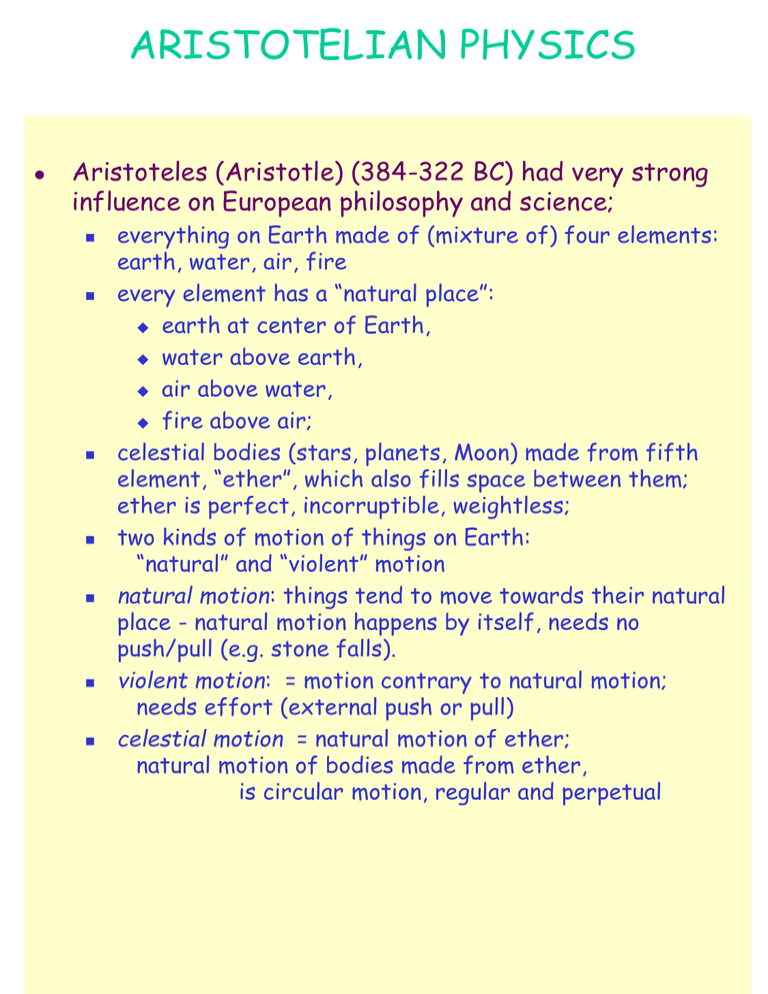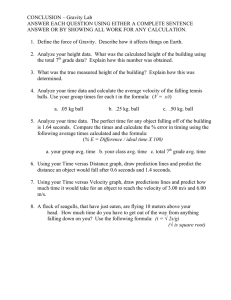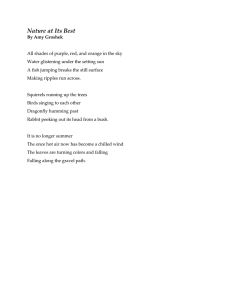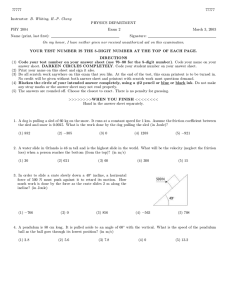Galilei
advertisement

ARISTOTELIAN PHYSICS Aristoteles (Aristotle) (384-322 BC) had very strong influence on European philosophy and science; everything on Earth made of (mixture of) four elements: earth, water, air, fire every element has a “natural place”: earth at center of Earth, water above earth, air above water, fire above air; celestial bodies (stars, planets, Moon) made from fifth element, “ether”, which also fills space between them; ether is perfect, incorruptible, weightless; two kinds of motion of things on Earth: “natural” and “violent” motion natural motion: things tend to move towards their natural place - natural motion happens by itself, needs no push/pull (e.g. stone falls). violent motion: = motion contrary to natural motion; needs effort (external push or pull) celestial motion = natural motion of ether; natural motion of bodies made from ether, is circular motion, regular and perpetual Problems with aristotelian physics: Galileo Galilei's thought experiments and real experiments: falling bodies: according to Aristoteles, heavy bodies (contain more earth element) fall faster than lighter bodies observation: fall equally fast if they have same shape and size Galilei: difference in speed of differently shaped falling bodies due to air resistance thought experiment about two falling bodies “reductio ad absurdum': consider two bodies, one light (L), one heavy (H) Aristoteles: L falls more slowly than H L put under H should slow down fall of H; H with L under it should fall more slowly than H alone; but (L + H) heavier than H alone should fall faster than H alone contradiction. pendulum: ball suspended on string reaches same height as that to which it was lifted to set it in motion (not quite; due to friction); height independent of path (pendulum with shortened string) ball rolling on inclined plane: ball rolling down inclined plane speeds up; ball rolling up slows down; rate of slowing down depends on steepness of incline: less steep longer distance travelled; extrapolation to zero slope of incline: ball will go on forever GALILEI'S NEW SCIENCE Galileo Galilei (1564 - 1642)founder of modern science; LAW OF INERTIA: new methods introduced by Galilei include: controlled experiments designed to test specific hypotheses idealizations to eliminate any side effects that might obscure main effects limiting the scope of enquiry - consider only one question at a time; quantitative methods - did careful measurements of the motion of falling bodies. from observations and thought experiments, generalizes to two new laws: without external influence (force) acting on it, a body will not change its speed or direction of motion; it will stay at rest if it was at rest to begin with. inertia = property of bodies that makes them obey this law, their ability to maintain their speed (or stay at rest) LAW OF FALLING: if air resistance is negligible, any two objects that are dropped together will fall together; speed of falling independent of weight and material.




